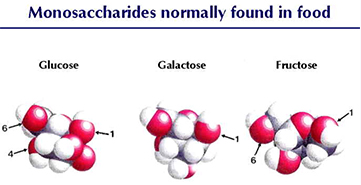What are carbohydrates and sugar?
Carbohydrates are broadly classified into monosaccharides, disaccharides and polysaccharides
Monosaccharides and disaccharides are otherwise known as 'sugars'
Polys or sugar alcohols are naturally found in some fruits and used commercially in products such as chewing gum
On average half of the energy we eat comes from carbohydrates - a complex group of compounds that can be defined based on their chemical structure. They all contain carbon, hydrogen and oxygen molecules. Carbohydrates almost exclusively come from plants, the exception being lactose from milk and a small number of sugars in red meat. When consumed, carbohydrates are broken down to provide energy to our cells.
Carbohydrates are split into several groups based on their chemical structures and how complex that structure is. The three most common groups are monosaccharides, disaccharides and polysaccharides. Sugars are carbohydrates that are chemically classified as monosaccharides and disaccharides.
Monosaccharides
 Monosaccharides include glucose, galactose and fructose - all commonly found in food.Monosaccharides are single sugar molecules that are the building blocks for all other sugars and carbohydrates. Glucose, fructose and galactose are examples of these.
Monosaccharides include glucose, galactose and fructose - all commonly found in food.Monosaccharides are single sugar molecules that are the building blocks for all other sugars and carbohydrates. Glucose, fructose and galactose are examples of these.
Disaccharides
Disaccharides are sugars that are made up of two single sugar units joined together. Lactose, the main sugar found in milk, is a disaccharide, and it has a galactose and a glucose molecule. Table sugar, also known as sucrose, is extracted from sugar cane and is another example. Sucrose is made of one glucose and one fructose unit joined together.
Polysaccharides
Other types of carbohydrates are made up of long chains of molecules with combinations of monosaccharides and disaccharides, and some have very complicated structures. These are known collectively as polysaccharides. They can range from 10 monomers to thousands of monomers. Examples of these carbohydrates are starch, cellulose, pectin, gums, and fibre. Polysaccharides may not be completely digested by enzymes within the body. They may require fermentation by colonic bateria.
Polyols
Polyols are alcohols of sugars. They are found naturally in some fruits and vegetables but are usually made commercially. An example is xylitol which is added to sugar free chewing gums, as sugar alcohols do not harm the teeth.
